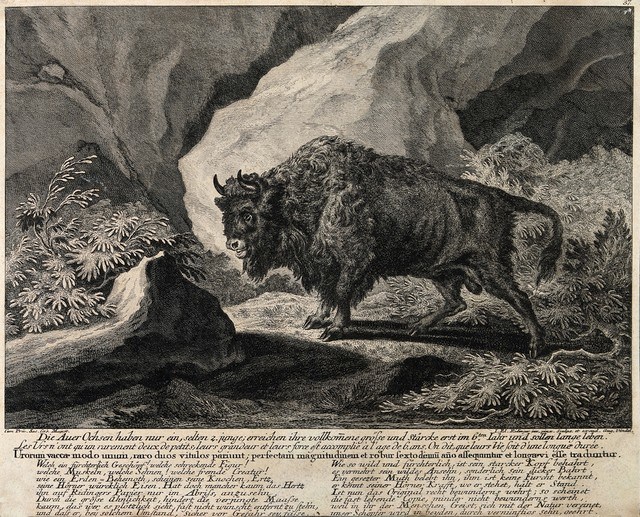
Etching by J.E. Ridinger, available in the Wellcome Collection: CC-BY-4.0
On the 12th of February, the Year of the Ox begins. Let’s call it the Year of the Aurochs (Bos primigenius): primordial oxen, the ancestors of cows. They carved paths through the woodlands and steppes of Europe, North Africa and Asia for hundreds of thousands of years, until 1627, when the last living aurochs was killed by a hunter in Poland. Today we graze cattle—beings we incessantly, and, I should say, needlessly, breed for their flesh and their milk—on the remnants of grasslands their ancestors shaped.
Groups of aurochs could trample us. Cows still can. This, I found out on a walk across a pasture with friends. Suddenly, as though alerted by some silent signal, a group of cows stampeded in our direction. We panicked, but managed to slip through a fence. That day we glimpsed an ancient law of nature, a law humanity broke by forcing those cows’ ancestors to reproduce, generation by generation, into smaller and more tractable beings. We have managed, indeed to turn a planet teeming with autonomous, evolving life into a world in which untamed beings cling to nooks and crannies as we cover the Earth with our livestock and pets.

Photo by Helena Lopes, via Unsplash.
Aurochs 2.0
The Tauros Programme aims to breed cattle back into their ancestral state. But how could these beings ever get their groove back? Can we replicate everything that moved them through the forests of the living Earth, thousands of years ago?
In any case, veterinary research teams and their backers have transported cattle to Dutch research sites, used artificial insemination for quick, genetically targeted breeding, and overseen the births of hundreds of calves. The selection and addition of new research cattle will continue indefinitely.
“Rewilding” Europe and promoting wildlife tourism, the narrative goes, could support rural economies and refresh over-farmed land. And so they would establish yet another human prerogative: After running animals off the planet, we could now reconstitute them as we see fit.
If only we could stop purpose-breeding and keeping animals, and leave evolution to its own devices, true re-wilding might begin. A complex web of interconnected life might resume its inimitable dynamic.
But with our cattle-using mindset firmly in place, what’s to stop hunter-tourists from stalking the “rewilded” oxen, or culinary adventurers from seeking tastes of wine-braised aurochs’ tails?
RewildingEurope.com lauds the aurochs as “the ancestor of all cattle and thereby the most important animal in the history of mankind.” The project’s high rating of these animals, interwoven as it is with domestication, is damning praise. There’s no better time than the Year of the Ox to interrogate it.
Thanks to Bill Drelles, Jack McMillan, Valerie McGowan, and former cattle farmer Harold Brown for helpful conversations during the writing of this piece.
The post The Year of the Aurochs appeared first on CounterPunch.org.
This post was originally published on CounterPunch.org.